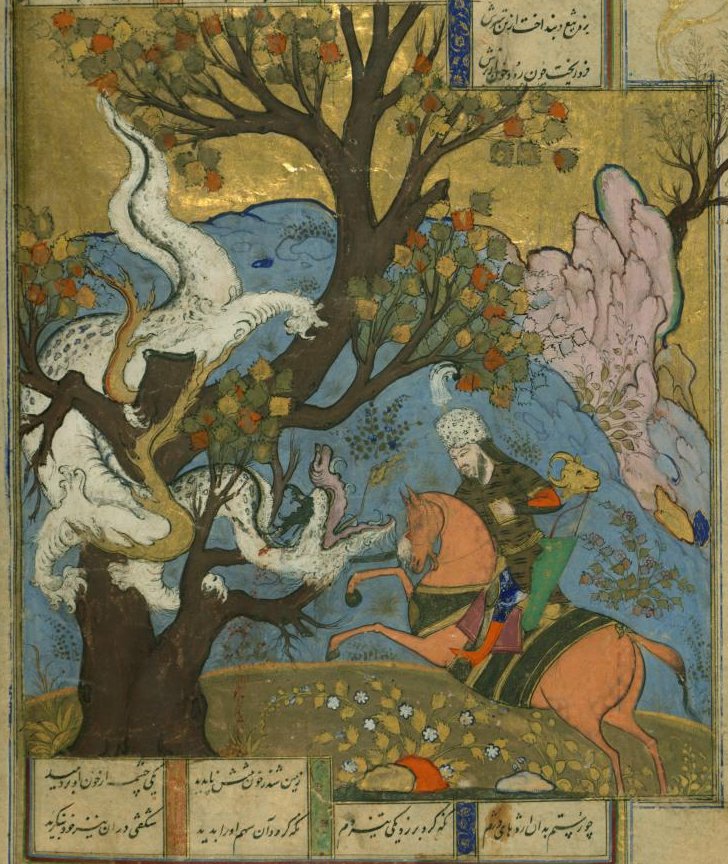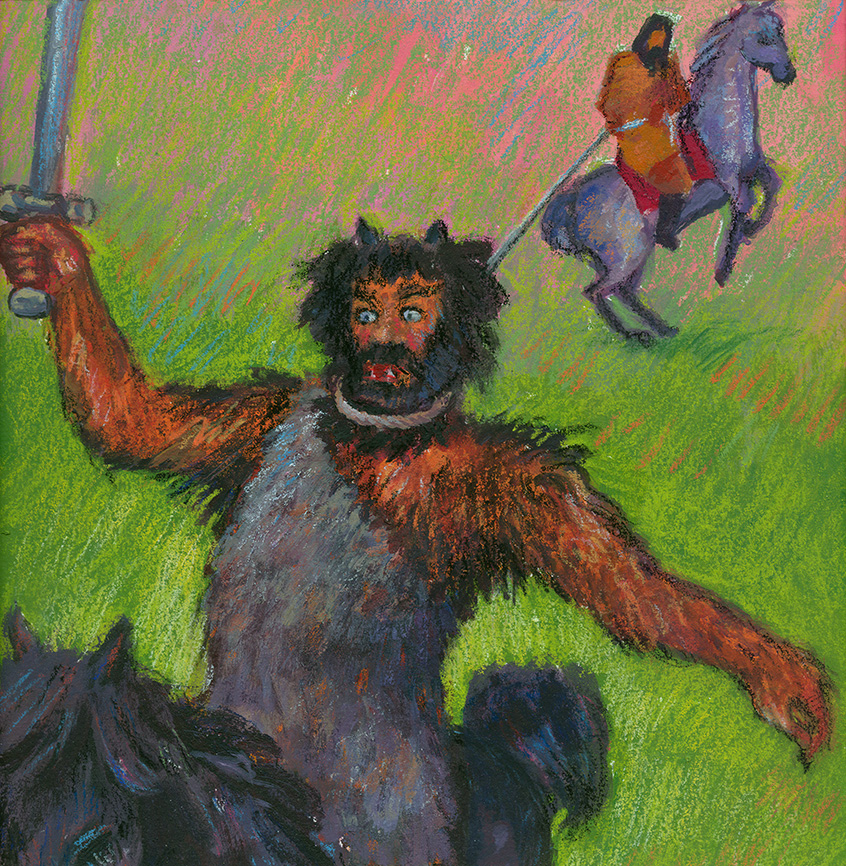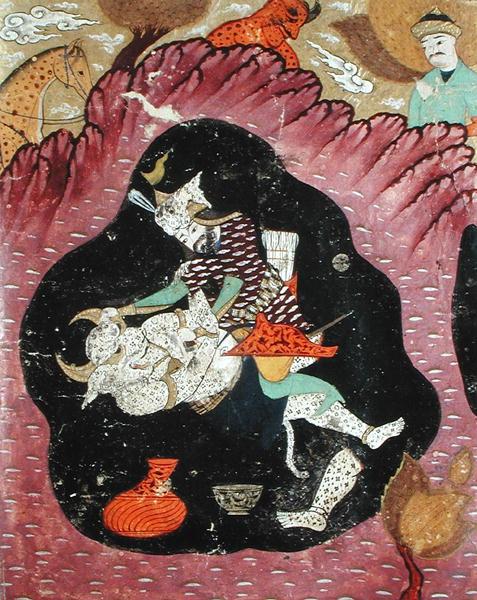Rostam's Seven Labours on:
[Wikipedia]
[Google]
[Amazon]
The Seven Labors of Rustam ( fa, هفت خان رستم, Haftkhān-e-Rostam) were a series of acts carried out by the greatest of the Iranian heroes,
 Rostam falls asleep among the reeds. After a short time, a fierce lion appears, and mounts a ferocious attack on his horse Rakhsh; but Rakhsh, although hard-pressed, succeeds in killing the savage beast with his teeth and hooves. Rostam, awakened by the tumult, and seeing the dead lion and the wounded Rakhsh before him, makes haste to heal his beloved steed, before remounting him and continuing on his way toward Mazanderan.
* The Second Labour:
Rostam enters a desert, in which no water is to be found. Both horse and rider become oppressed with thirst and therefore, Rostam prays to God. Sweltering under the burning sun, Rostam sees a sheep pass by, which he hails as the harbinger of good. Rising up and grasping his sword in his hand, he follows the animal, and comes to a fountain of water, where he devoutly returns thanks to God for the blessing which has preserved his existence.
*The Third Labour:
Rostam falls asleep among the reeds. After a short time, a fierce lion appears, and mounts a ferocious attack on his horse Rakhsh; but Rakhsh, although hard-pressed, succeeds in killing the savage beast with his teeth and hooves. Rostam, awakened by the tumult, and seeing the dead lion and the wounded Rakhsh before him, makes haste to heal his beloved steed, before remounting him and continuing on his way toward Mazanderan.
* The Second Labour:
Rostam enters a desert, in which no water is to be found. Both horse and rider become oppressed with thirst and therefore, Rostam prays to God. Sweltering under the burning sun, Rostam sees a sheep pass by, which he hails as the harbinger of good. Rising up and grasping his sword in his hand, he follows the animal, and comes to a fountain of water, where he devoutly returns thanks to God for the blessing which has preserved his existence.
*The Third Labour:

 At midnight a monstrous serpentine dragon emerges from the forest; Rakhsh approaches his sleeping master and neighs and beats the ground so furiously, that he succeeds in waking him. Rostam looks around, but, seeing nothing, because the dragon has already vanished, grumbles and goes back to sleep. The dragon appears a second time and once again the faithful horse succeeds in rousing his master. Rostam is even angrier than before; but at this moment sufficient light is providentially given him to allow him to see the monster that has been causing Rakhsh such alarm. Rostam then slays the dragon.
*The Fourth Labour:
Rostam, back in the saddle once more, continues his journey through enchanted lands, and comes, at evening, to a beautiful glade refreshed by limpid streams, where he finds, much to his surprise, a ready-roasted deer, together with the bread and salt to accompany it. He sits down to the mysterious banquet, but it vanishes at the sound of his voice. Next he sees a
At midnight a monstrous serpentine dragon emerges from the forest; Rakhsh approaches his sleeping master and neighs and beats the ground so furiously, that he succeeds in waking him. Rostam looks around, but, seeing nothing, because the dragon has already vanished, grumbles and goes back to sleep. The dragon appears a second time and once again the faithful horse succeeds in rousing his master. Rostam is even angrier than before; but at this moment sufficient light is providentially given him to allow him to see the monster that has been causing Rakhsh such alarm. Rostam then slays the dragon.
*The Fourth Labour:
Rostam, back in the saddle once more, continues his journey through enchanted lands, and comes, at evening, to a beautiful glade refreshed by limpid streams, where he finds, much to his surprise, a ready-roasted deer, together with the bread and salt to accompany it. He sits down to the mysterious banquet, but it vanishes at the sound of his voice. Next he sees a  Rostam conquers the Mazandarani champion Olad Deev, who describes the caves of the demons.
* The Sixth Labour:
Rostam conquers the Mazandarani champion Olad Deev, who describes the caves of the demons.
* The Sixth Labour:
 Rostam enters the city of Mazanderan, releases Shah Kai Kavus - still blind from the sorcery of the demons - and slays Arzhang Div.
* The Seventh Labour:
Rostam enters the city of Mazanderan, releases Shah Kai Kavus - still blind from the sorcery of the demons - and slays Arzhang Div.
* The Seventh Labour:

 Rostam overthrows and kills Div-e-Sepid, the White Demon. The blood of the White Demon's heart restores Kai Kavus's sight.
Rostam also kills the magician king of Mazandaran (not to be confused with Mazandaran Province) and returns to Estakhr accompanied by the
Rostam overthrows and kills Div-e-Sepid, the White Demon. The blood of the White Demon's heart restores Kai Kavus's sight.
Rostam also kills the magician king of Mazandaran (not to be confused with Mazandaran Province) and returns to Estakhr accompanied by the
Center for Iranian Studies, Columbia University
Rostam
use both this parameter and , birth_date to display the person's date of birth, date of death, and age at death) -->
, death_place = Kabulistan
, death_cause = With the conspiracy of his half-brother Shaghad, he fell into a w ...
, The story was retold by Ferdowsi
, image = Statue of Ferdowsi in Tus, Iran 3 (cropped).jpg
, image_size =
, caption = Statue of Ferdowsi in Tus by Abolhassan Sadighi
, birth_date = 940
, birth_place = Tus, Samanid Empire
, death_date = 1019 or 1025 (87 years old)
, d ...
in his epic poem, Shahnameh
The ''Shahnameh'' or ''Shahnama'' ( fa, شاهنامه, Šāhnāme, lit=The Book of Kings, ) is a long epic poem written by the Persian poet Ferdowsi between c. 977 and 1010 CE and is the national epic of Greater Iran. Consisting of some 5 ...
. The Seven Labours were seven difficult tasks undertaken by Rostam, accompanied, in most instances, only by his faithful and sagacious steed Rakhsh, although in two labours he was accompanied also by the champion, Olad.
The Haftkhān
According to the traditional narrative, the story starts whenKay Kāvus
Kay Kāvus ( fa, کیکاووس; ae, 𐬐𐬀𐬎𐬎𐬌 𐬎𐬯𐬀𐬥 Kauui Usan); sometimes ''Kai-Káús'' or ''Kai-Kaus'', Firdawsī, ''The Sháh námeh of the Persian poet Firdausí''. Oriental Translation Fund. Volume 21 of Publicat ...
's expedition to Mazandaran fails, and his army is captured by the Divs. Rostam undertakes to liberate it, and achieves his goal by performing the labours. The traditional order of the seven is as follows:
* The First Labour:
 Rostam falls asleep among the reeds. After a short time, a fierce lion appears, and mounts a ferocious attack on his horse Rakhsh; but Rakhsh, although hard-pressed, succeeds in killing the savage beast with his teeth and hooves. Rostam, awakened by the tumult, and seeing the dead lion and the wounded Rakhsh before him, makes haste to heal his beloved steed, before remounting him and continuing on his way toward Mazanderan.
* The Second Labour:
Rostam enters a desert, in which no water is to be found. Both horse and rider become oppressed with thirst and therefore, Rostam prays to God. Sweltering under the burning sun, Rostam sees a sheep pass by, which he hails as the harbinger of good. Rising up and grasping his sword in his hand, he follows the animal, and comes to a fountain of water, where he devoutly returns thanks to God for the blessing which has preserved his existence.
*The Third Labour:
Rostam falls asleep among the reeds. After a short time, a fierce lion appears, and mounts a ferocious attack on his horse Rakhsh; but Rakhsh, although hard-pressed, succeeds in killing the savage beast with his teeth and hooves. Rostam, awakened by the tumult, and seeing the dead lion and the wounded Rakhsh before him, makes haste to heal his beloved steed, before remounting him and continuing on his way toward Mazanderan.
* The Second Labour:
Rostam enters a desert, in which no water is to be found. Both horse and rider become oppressed with thirst and therefore, Rostam prays to God. Sweltering under the burning sun, Rostam sees a sheep pass by, which he hails as the harbinger of good. Rising up and grasping his sword in his hand, he follows the animal, and comes to a fountain of water, where he devoutly returns thanks to God for the blessing which has preserved his existence.
*The Third Labour:

 At midnight a monstrous serpentine dragon emerges from the forest; Rakhsh approaches his sleeping master and neighs and beats the ground so furiously, that he succeeds in waking him. Rostam looks around, but, seeing nothing, because the dragon has already vanished, grumbles and goes back to sleep. The dragon appears a second time and once again the faithful horse succeeds in rousing his master. Rostam is even angrier than before; but at this moment sufficient light is providentially given him to allow him to see the monster that has been causing Rakhsh such alarm. Rostam then slays the dragon.
*The Fourth Labour:
Rostam, back in the saddle once more, continues his journey through enchanted lands, and comes, at evening, to a beautiful glade refreshed by limpid streams, where he finds, much to his surprise, a ready-roasted deer, together with the bread and salt to accompany it. He sits down to the mysterious banquet, but it vanishes at the sound of his voice. Next he sees a
At midnight a monstrous serpentine dragon emerges from the forest; Rakhsh approaches his sleeping master and neighs and beats the ground so furiously, that he succeeds in waking him. Rostam looks around, but, seeing nothing, because the dragon has already vanished, grumbles and goes back to sleep. The dragon appears a second time and once again the faithful horse succeeds in rousing his master. Rostam is even angrier than before; but at this moment sufficient light is providentially given him to allow him to see the monster that has been causing Rakhsh such alarm. Rostam then slays the dragon.
*The Fourth Labour:
Rostam, back in the saddle once more, continues his journey through enchanted lands, and comes, at evening, to a beautiful glade refreshed by limpid streams, where he finds, much to his surprise, a ready-roasted deer, together with the bread and salt to accompany it. He sits down to the mysterious banquet, but it vanishes at the sound of his voice. Next he sees a tanbur
The term ''Tanbur'' ( fa, تنبور, ) can refer to various long-necked string instruments originating in Mesopotamia, Southern or Central Asia. According to the '' New Grove Dictionary of Music and Musicians'', "terminology presents a compli ...
and a flask of wine: taking up the instrument, he plays upon it, improvising a ditty about his own wanderings, and the kinds of exploit which he loves best. The song reaches the ears of the alluring sorceress responsible for the fairy banquet, who suddenly appears and sits down at his side. Rostam offers up a prayer of thanks for having been supplied with food, wine, and music in so inhospitable a place as the desert of Mazanderan, and, not realising that the enchantress is, in fact, a demon in disguise, he places in her hands a cup of wine in the name of God; but, at the mention of the Creator, the temptress is forced to resume her true form - that of a black fiend. Seeing this, Rostam holds her fast with his lasso, before drawing his sword and cleaving her in two.
This labour bears a marked resemblance to an episode involving the temptation of Sir Perceval in the Grail
The Gravity Recovery and Interior Laboratory (GRAIL) was an American lunar science mission in NASA's Discovery Program which used high-quality gravitational field mapping of the Moon to determine its interior structure. The two small spacecraf ...
quest section of the thirteenth century Arthurian text known as the Vulgate cycle and also as the Lancelot-Grail
The ''Lancelot-Grail'', also known as the Vulgate Cycle or the Pseudo-Map Cycle, is an early 13th-century French Arthurian literary cycle consisting of interconnected prose episodes of chivalric romance in Old French. The cycle of unknown author ...
. This resemblance may be due to the borrowing of material from the Persian text into the European. Such borrowings have been detected before in certain Arthurian romances - notably in the ''Parzival
''Parzival'' is a medieval romance by the knight-poet Wolfram von Eschenbach in Middle High German. The poem, commonly dated to the first quarter of the 13th century, centers on the Arthurian hero Parzival (Percival in English) and his long ...
'' of Wolfram von Eschenbach
Wolfram von Eschenbach (; – ) was a German knight, poet and composer, regarded as one of the greatest epic poets of medieval German literature. As a Minnesinger, he also wrote lyric poetry.
Life
Little is known of Wolfram's life. There ar ...
and the ''Jungerer Titurel'' of Albrecht von Scharfenberg, in which the description of the Grail temple is strongly reminiscent of the Takht-e Soleymān
Takht-e Soleymān ( fa, تخت سلیمان, lit=Throne of Solomon), is an archaeological site in West Azerbaijan, Iran dating back to Sasanian Empire. It lies midway between Urmia and Hamadan, very near the present-day town of Takab, and west ...
.
* The Fifth Labour:
 Rostam conquers the Mazandarani champion Olad Deev, who describes the caves of the demons.
* The Sixth Labour:
Rostam conquers the Mazandarani champion Olad Deev, who describes the caves of the demons.
* The Sixth Labour:
 Rostam enters the city of Mazanderan, releases Shah Kai Kavus - still blind from the sorcery of the demons - and slays Arzhang Div.
* The Seventh Labour:
Rostam enters the city of Mazanderan, releases Shah Kai Kavus - still blind from the sorcery of the demons - and slays Arzhang Div.
* The Seventh Labour:

 Rostam overthrows and kills Div-e-Sepid, the White Demon. The blood of the White Demon's heart restores Kai Kavus's sight.
Rostam also kills the magician king of Mazandaran (not to be confused with Mazandaran Province) and returns to Estakhr accompanied by the
Rostam overthrows and kills Div-e-Sepid, the White Demon. The blood of the White Demon's heart restores Kai Kavus's sight.
Rostam also kills the magician king of Mazandaran (not to be confused with Mazandaran Province) and returns to Estakhr accompanied by the Shah
Shah (; fa, شاه, , ) is a royal title that was historically used by the leading figures of Iranian monarchies.Yarshater, EhsaPersia or Iran, Persian or Farsi, ''Iranian Studies'', vol. XXII no. 1 (1989) It was also used by a variety of ...
.
See also
* Esfandiyār's Seven Labors another tale from the Shahnameh with the same structure. *Labours of Hercules
The Labours of Hercules or Labours of Heracles ( grc-gre, wikt:ὁ, οἱ wikt:Ἡρακλῆς, Ἡρακλέους wikt:ἆθλος, ἆθλοι, ) are a series of episodes concerning a penance carried out by Heracles, the greatest of the ...
Ancient Greek tale of another Indo-European hero showing similarities to those of Rostam and Esfandiyār.
Sources and references
* Abolqasem Ferdowsi, Dick Davis trans. (2006), ''Shahnameh: The Persian Book of Kings'' , modern English translation (abridged), current standard * Warner, Arthur and Edmond Warner, (translators) The Shahnama of Firdausi, 9 vols. (London: Keegan Paul, 1905-1925) (complete English verse translation) * Shirzad Aghaee, ''Nam-e kasan va ja'i-ha dar Shahnama-ye Ferdousi'' (Personalities and Places in the Shahnama of Ferdousi, Nyköping, Sweden, 1993. () * Jalal Khāleghi Motlagh, Editor, ''The Shahnameh'', to be published in 8 volumes (ca. 500 pages each), consisting of six volumes of text and two volumes of explanatory notes. SeeCenter for Iranian Studies, Columbia University
References
{{Reflist Persian mythology Medieval legends Shahnameh stories